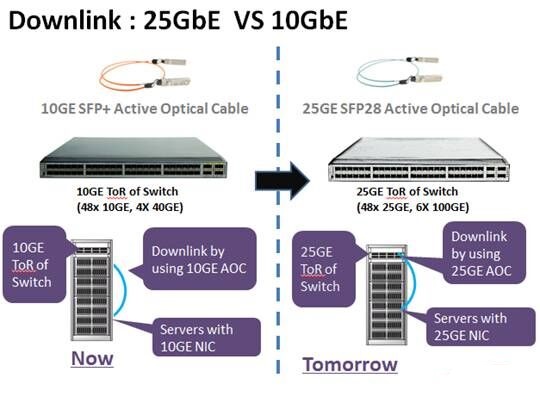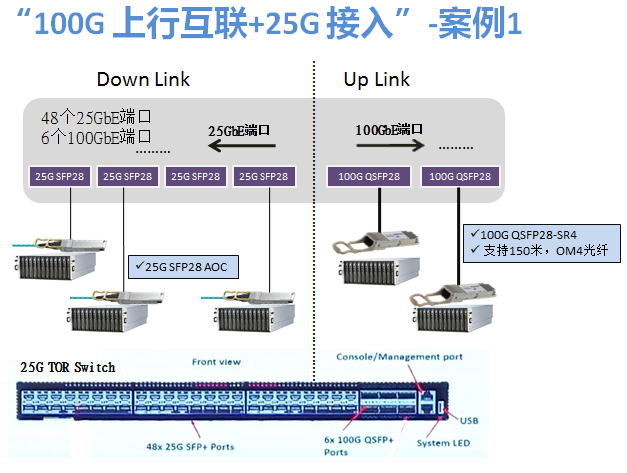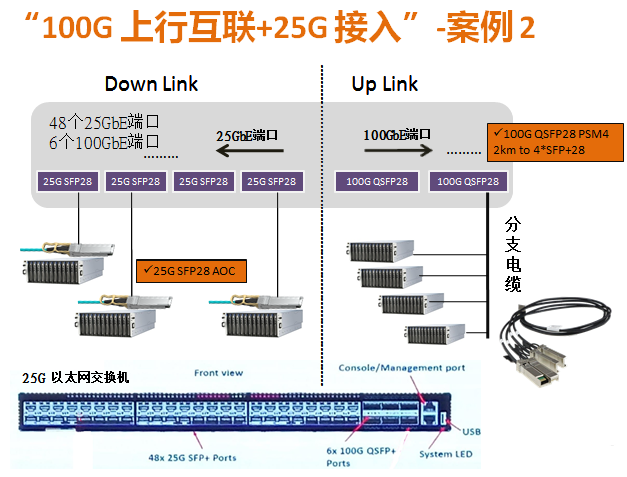After 40 years of development, as its name ETHER, Ethernet has reached the aim of the pioneers, i.e., "Ethernet everywhere", become the media in everywhere of human information society. With the rapid development of Internet, cloud computing and big data in recent years, the construction of IT infrastructure data center has been accelerated. A new round of updating is underway for the Ethernet in the data center, of them 25G Ethernet is favored.
Let’s take a look at the changes of equipment port in the data center, as shown below:

The demand of data center for Ethernet comes from two important considerations. One is energy saving and the other is cost. The area related to the development of data center includes the development of cloud and Leaf/Spine matrix network architecture. With the further enhance of server performance and the updating of data center from leaf and spine layer connection to 100Gbps, the updating of server from existing 10Gbps to 25Gbps/50Gbps has a great practical significance: because the 10G Ethernet speed often cannot meet the demands, but the price of 100G is too high, the appearance of 25G and 50G Ethernet standards has just made up for the deficiency of them. In addition, the 25Gbps and 50Gbps per channel technology will the basis of future 100Gbps (4 25Gbps) and 400Gbps (8 50Gbps) Ethernet standards. Therefore, it is expected to replace the existing 10Gbps rate using 25G transmission rate in this industry.

Introduction of technology advantages of 25GE
With respect to 40GE, 25GE enjoys the cost advantages of single channel. If it is 40G, multiple physical channels are required, because it makes use of 10G technology. For 25G Ethernet, the key advantage is that many components have been completed: because 100G Ethernet is formed by 4 25Gbps. Therefore, the components generated using the two kinds of technology can be produced in mass, to drive down the price. Through Quad-SFP interfaces (QSFP), 100G is divided into 4 25G, 40G is divided into 4 10G, so the multi-rate Ethernet products will be developed and applied.
Obtain faster performance and higher base using the same low-cost copper core cable. The specifications specify that: By using a single switch / NIC SerDes channel, the bandwidth provided by 25 Gigabit Ethernet link is 2.5 times that provide by the 10Gbps link using two pairs of biaxial copper cable SFP + direct-connection copper cable (DAC). By using 2 switch / NIC SerDes channels which are running at 25Gbps, 50 Gigabit Ethernet link can provide the bandwidth which is 25% more than that provided by 40 Gigabit Ethernet link. In addition, compared with the current QSFP+DAC wiring, half of biaxial copper cables (4) is used in the specifications. When the rate of each channel is 25Gbps, the running speed of switch of NIC chip will become faster, while the power consumption will be raised slightly. However, after the realization of standardization of bandwidth, the advantages of cost and power consumption will become more apparent.
Compared with 40GE, for the connection of 25GE Ethernet server to 25GE TOR switch, 25GE can support higher server density in the rack.

For “port density”, compared with the current 10 Gigabit or 40 Gigabit Ethernet connections, the 25 Gigabit and 50 Gigabit Ethernet links defined by “25 Gigabit Ethernet Alliance” can improve the performance of all serializer / deserializer (SerDes) channels and biaxial copper cable. Such performance can save the cost of rack-level interconnection of bandwidth per unit by above 50%, and thus significantly improve the breakeven level of MSDC operators. In addition, the implementation of this specification can also broaden network size (commonly referred to as he base), and compared to the connection from 40 Gigabit Ethernet server to TOR, it can support higher server density in the rack.
the actual application scenes:







 Interconnection Solution for Next Generation...
Interconnection Solution for Next Generation...
 Date Center
Date Center